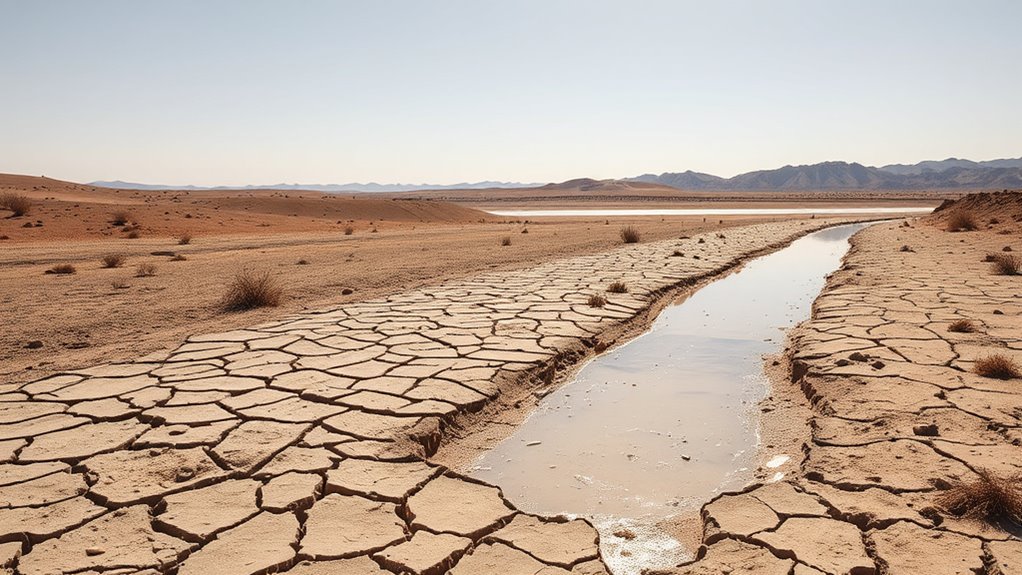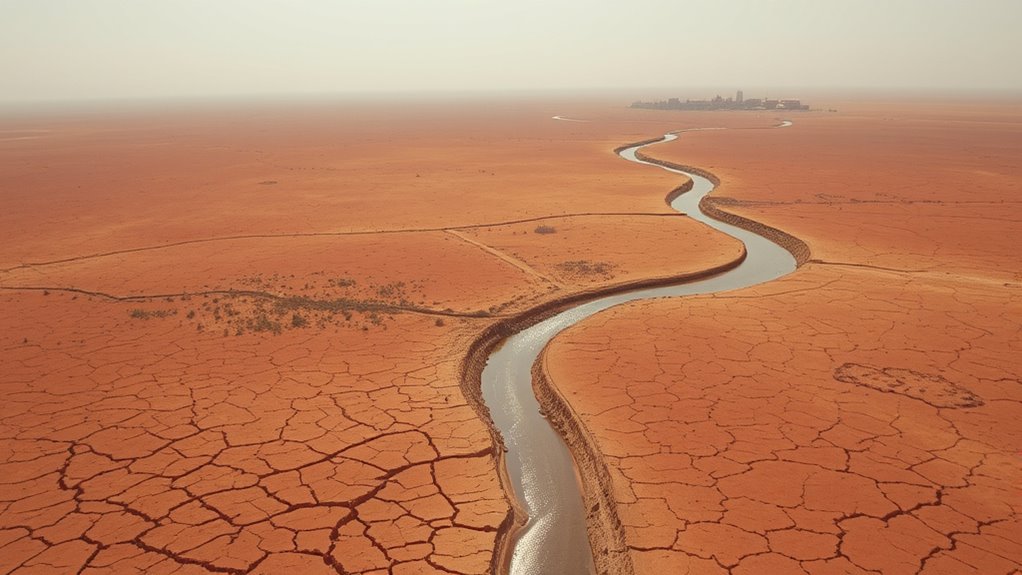A recent study shows that about 25% of the world’s population faces extreme water stress, which can impact communities, ecosystems, and economies. Water scarcity worsens with climate change, disrupting rainfall patterns and melting glaciers. Simple actions like fixing leaks, choosing water-efficient appliances, and supporting sustainable policies can help. Understanding your role in conservation is crucial—if you keep exploring, you’ll discover practical ways to make a difference and protect water resources for the future.
Key Takeaways
- Approximately 25% of the global population experiences severe water scarcity, impacting health, agriculture, and economies.
- Climate change worsens water stress by altering rainfall patterns and melting glaciers, reducing freshwater sources.
- Water conservation and efficient management are essential to mitigate pressure on limited water resources.
- Water scarcity threatens food security by affecting agriculture and crop productivity worldwide.
- Collective community actions and policies are vital for ensuring sustainable water availability in the future.

A new study reveals that nearly a quarter of the world’s population is experiencing extreme water stress, highlighting a growing global crisis. This situation demands your urgent attention because water scarcity isn’t just about running out of a glass of water—it’s about the future of communities, ecosystems, and economies. As climate impact intensifies, the availability of freshwater becomes increasingly unpredictable, making water conservation more crucial than ever. When you waste water, you’re not only depleting a precious resource but also contributing to a cycle that worsens climate effects like droughts and rising temperatures. Every drop saved can help ease the pressure on strained water systems and reduce the overall environmental footprint.
Understanding the link between water conservation and climate impact is essential. Climate change disrupts rainfall patterns, causes more frequent droughts, and melts glaciers that supply freshwater to millions. As these changes accelerate, regions that once relied on predictable water sources now face shortages. You can help by adopting simple water-saving habits—fixing leaks, turning off taps when not in use, and choosing water-efficient appliances. Small actions add up, especially when multiplied across communities. Additionally, supporting policies that promote sustainable water management can influence larger systemic changes, ensuring that scarce resources are allocated efficiently and fairly. Promoting awareness about water issues is also vital for fostering community engagement and encouraging responsible behavior on a broader scale. Your choices, both daily and political, can influence how communities adapt to climate challenges and how resilient their water infrastructure becomes.
Climate change disrupts rainfall and melts glaciers, making water conservation and policy support crucial for sustainable water resilience.
The impact of climate-driven water stress extends beyond individual households. Agriculture, which consumes about 70% of freshwater globally, faces severe constraints, threatening food security. When water becomes scarce, farmers must adapt by changing crops or investing in costly irrigation systems. These measures add economic strain and can lead to increased prices and food shortages. As a consumer, you can support sustainable agriculture practices by choosing locally sourced, water-efficient products. These actions not only reduce your water footprint but also send a message to producers and policymakers that sustainable practices matter. Recognizing the importance of water resource management can help communities develop more resilient systems to withstand climate variability.
Ultimately, confronting water stress requires collective effort. You can advocate for responsible water policies, participate in local conservation programs, or educate others about the importance of water conservation. Climate impact is a pressing driver of water scarcity, but individual actions play a crucial role in mitigating its effects. By making conscious choices and encouraging others to do the same, you contribute to a broader movement that prioritizes sustainable water use. The future of water availability depends on how well you and your community adapt today—because every effort counts in tackling this urgent global crisis.
Frequently Asked Questions
What Are the Main Causes of Water Stress Globally?
You face water stress mainly because of factors like agricultural runoff, which pollutes water sources, and climate change, causing irregular rainfall and droughts. These issues reduce the availability of clean water for drinking, farming, and industry. When you understand these causes, you can take action to conserve water, support sustainable practices, and advocate for policies that address climate change and reduce pollution, helping to alleviate global water stress.
How Does Water Stress Affect Local Economies?
You’ll see water stress cause significant economic impacts in your community, like reduced agricultural output, higher costs for water treatment, and job losses. These challenges weaken community resilience, making it harder to recover from economic shocks. When water becomes scarce, local economies suffer, affecting everyone’s livelihoods and future growth. Addressing water stress proactively helps protect your community’s economic stability and supports long-term resilience.
Are There Regions With Increasing Water Availability?
You might notice some regions experiencing increased water availability due to effective regional water policies and climate change impacts. Areas with proactive management and sustainable practices can see improvements, especially where climate change impacts are mitigated or managed well. These regions often invest in infrastructure and conservation, helping boost water supplies. Stay informed about local initiatives, as they play a vital role in enhancing water availability despite global challenges.
What Technologies Can Help Mitigate Water Scarcity?
You can use desalination technology to turn seawater into freshwater, making it a vital tool in water-scarce areas. Water recycling also plays a critical role by treating wastewater for reuse in agriculture, industry, or even drinking. Together, these technologies help reduce water scarcity, ensuring communities have reliable access to clean water and lessening the strain on natural sources. Implementing them is essential for a sustainable water future.
How Can Individuals Contribute to Reducing Water Stress?
You can contribute to reducing water stress by practicing water conservation in your daily routines, like fixing leaks and using efficient fixtures. Additionally, get involved in community action efforts that promote sustainable water use. Your participation can inspire others to follow suit, creating a collective impact. Small changes, when adopted widely, considerably ease water scarcity issues and help protect this essential resource for future generations.
Conclusion
Imagine over a quarter of the world’s population struggling with extreme water stress—that’s about two billion people. You can’t help but picture vast regions drying up, communities facing shortages, and daily life becoming harder. This striking statistic reminds you how urgent it is to address water management issues worldwide. If we don’t act now, millions may face even greater hardships in the near future. The time to prioritize water sustainability is clearly now.









